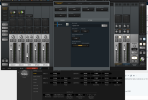likethehotels
New Member
I've been trying to do my research and search before posting, but still haven't been able to find the answers I need.
I can't be the only one dealing with this, so I'm hoping someone on this forum can help.
I finally got my waitlist invitation for the FM9 Turbo and ordered it. Now I want to make sure I have everything I need to record at home with both my FM9 as well as my interface. Here's my setup:
PC: Windows 10 with plenty of ram and CPU
DAW: Ableton 11 Suite
Interface: Apollo Twin USB
I'd like to get other user's experience as to the best way to connect my FM9 to my computer alongside my Apollo Twin USB.
I know analog is always an option, but I'm trying to avoid unnecessary conversion.
Since I have to run a USB cable from the FM9 to the PC in order to use FM9 Edit, I initially wanted to record USB audio.
That was until I realized that Windows cannot create an aggregate device, so I would have to disconnect my monitors from the FM9 and connect them to my Apollo any time I want to record through the Apollo.
It looks like the only solution here is ASIO4ALL. If someone else here has had good experience with it, I'd be interested in learning the right configuration, but all my experiences in the past with ASIO4ALL resulted in latency and buggy issues with the UA Console drivers disconnecting from the Apollo. Maybe someone out there is using it successfully (and if you are, please let me know how), but as of this moment, that seems like a dead-end. This is where I really start to understand the benefits of Macs and their "Core Audio."
Okay, then. Maybe that's what SPDIF is here for. I have three main concerns here:
1. What is the appropriate coax to optical converter here? Will I experience any latency with the options on Amazon? Any recommended converters?
2. Do I lose the ability to record a DI alongside a stereo signal? Not a dealbreaker, but nice to know what the limitations are to this.
3. Do I lose the ability to digitally re-amp through the FM9? The Apollo doesn't support SPDIF out, so I suspect that's the case. Again, not a dealbreaker, but just nice to know. Perhaps for reamping, I'll use analog and just have an unavoidable extra conversion.
Lastly, am I correct in assuming the editor software can run at the same as I'm recording through the FM9? No limitations there, right?
I can't be the only one with these questions, but I've been researching for 2.5 hrs and still can't quite find the right answers.
So, anyhow, this is my first post. Thanks for your help!
I can't be the only one dealing with this, so I'm hoping someone on this forum can help.
I finally got my waitlist invitation for the FM9 Turbo and ordered it. Now I want to make sure I have everything I need to record at home with both my FM9 as well as my interface. Here's my setup:
PC: Windows 10 with plenty of ram and CPU
DAW: Ableton 11 Suite
Interface: Apollo Twin USB
I'd like to get other user's experience as to the best way to connect my FM9 to my computer alongside my Apollo Twin USB.
I know analog is always an option, but I'm trying to avoid unnecessary conversion.
Since I have to run a USB cable from the FM9 to the PC in order to use FM9 Edit, I initially wanted to record USB audio.
That was until I realized that Windows cannot create an aggregate device, so I would have to disconnect my monitors from the FM9 and connect them to my Apollo any time I want to record through the Apollo.
It looks like the only solution here is ASIO4ALL. If someone else here has had good experience with it, I'd be interested in learning the right configuration, but all my experiences in the past with ASIO4ALL resulted in latency and buggy issues with the UA Console drivers disconnecting from the Apollo. Maybe someone out there is using it successfully (and if you are, please let me know how), but as of this moment, that seems like a dead-end. This is where I really start to understand the benefits of Macs and their "Core Audio."
Okay, then. Maybe that's what SPDIF is here for. I have three main concerns here:
1. What is the appropriate coax to optical converter here? Will I experience any latency with the options on Amazon? Any recommended converters?
2. Do I lose the ability to record a DI alongside a stereo signal? Not a dealbreaker, but nice to know what the limitations are to this.
3. Do I lose the ability to digitally re-amp through the FM9? The Apollo doesn't support SPDIF out, so I suspect that's the case. Again, not a dealbreaker, but just nice to know. Perhaps for reamping, I'll use analog and just have an unavoidable extra conversion.
Lastly, am I correct in assuming the editor software can run at the same as I'm recording through the FM9? No limitations there, right?
I can't be the only one with these questions, but I've been researching for 2.5 hrs and still can't quite find the right answers.
So, anyhow, this is my first post. Thanks for your help!

